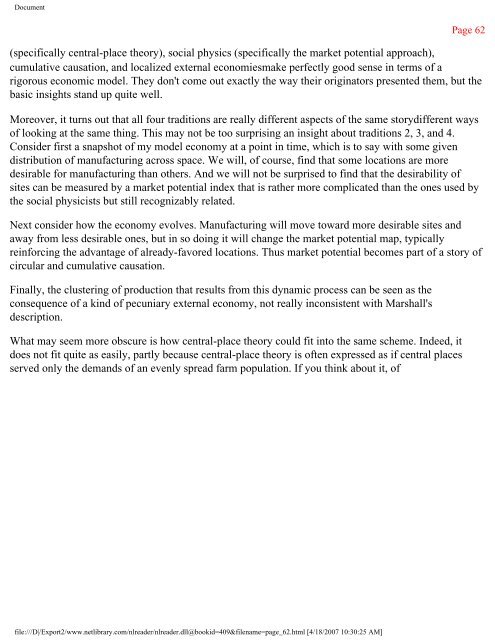Document file:///D|/Export1/www.netlibrary.com/nlreader/nlreader.dll ...
Document file:///D|/Export1/www.netlibrary.com/nlreader/nlreader.dll ...
Document file:///D|/Export1/www.netlibrary.com/nlreader/nlreader.dll ...
You also want an ePaper? Increase the reach of your titles
YUMPU automatically turns print PDFs into web optimized ePapers that Google loves.
<strong>Document</strong><br />
Page 62<br />
(specifically central-place theory), social physics (specifically the market potential approach),<br />
cumulative causation, and localized external economies make perfectly good sense in terms of a<br />
rigorous economic model. They don't <strong>com</strong>e out exactly the way their originators presented them, but the<br />
basic insights stand up quite well.<br />
Moreover, it turns out that all four traditions are really different aspects of the same story different ways<br />
of looking at the same thing. This may not be too surprising an insight about traditions 2, 3, and 4.<br />
Consider first a snapshot of my model economy at a point in time, which is to say with some given<br />
distribution of manufacturing across space. We will, of course, find that some locations are more<br />
desirable for manufacturing than others. And we will not be surprised to find that the desirability of<br />
sites can be measured by a market potential index that is rather more <strong>com</strong>plicated than the ones used by<br />
the social physicists but still recognizably related.<br />
Next consider how the economy evolves. Manufacturing will move toward more desirable sites and<br />
away from less desirable ones, but in so doing it will change the market potential map, typically<br />
reinforcing the advantage of already-favored locations. Thus market potential be<strong>com</strong>es part of a story of<br />
circular and cumulative causation.<br />
Finally, the clustering of production that results from this dynamic process can be seen as the<br />
consequence of a kind of pecuniary external economy, not really inconsistent with Marshall's<br />
description.<br />
What may seem more obscure is how central-place theory could fit into the same scheme. Indeed, it<br />
does not fit quite as easily, partly because central-place theory is often expressed as if central places<br />
served only the demands of an evenly spread farm population. If you think about it, of<br />
<strong>file</strong>:///<strong>D|</strong>/Export2/<strong>www</strong>.<strong>netlibrary</strong>.<strong>com</strong>/<strong>nlreader</strong>/<strong>nlreader</strong>.<strong>dll</strong>@bookid=409&<strong>file</strong>name=page_62.html [4/18/2007 10:30:25 AM]
















